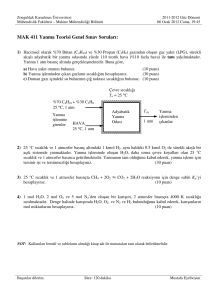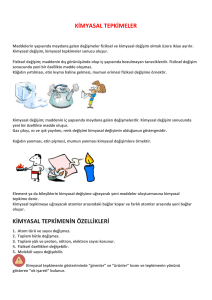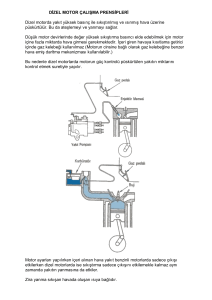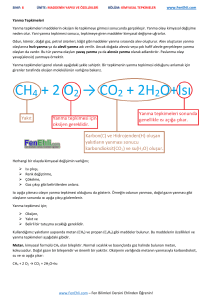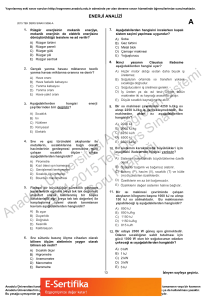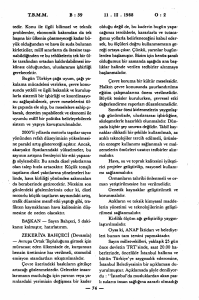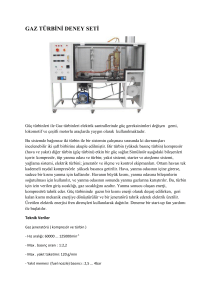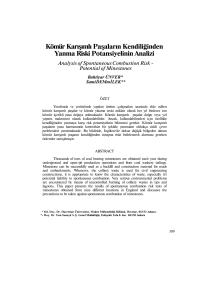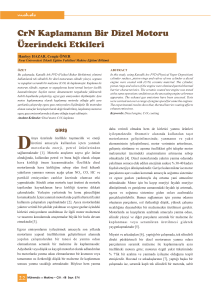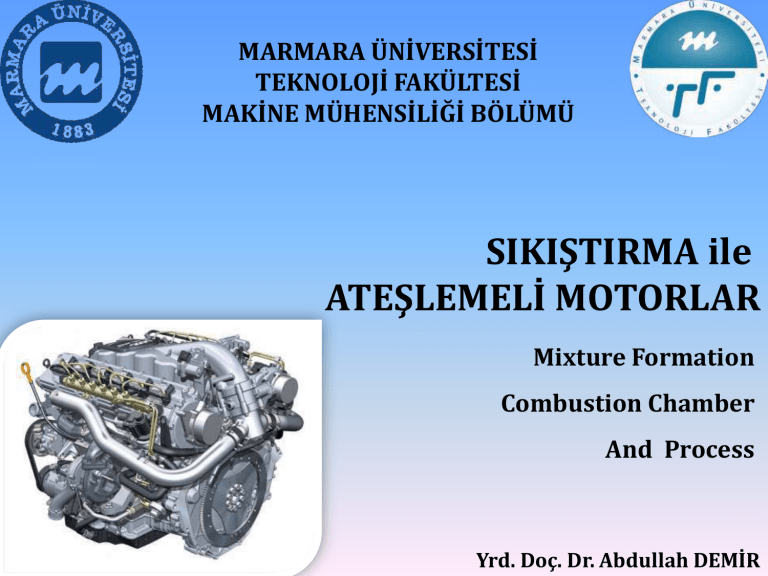
MARMARA ÜNİVERSİTESİ
TEKNOLOJİ FAKÜLTESİ
MAKİNE MÜ(ENSİLİĞİ BÖLÜMÜ
S)K)ŞT)RMA ile
ATEŞLEMELİ MOTORLAR
Mixture Formation
Combustion Chamber
And Process
Yrd. Doç. Dr. Abdullah DEMİR
MIXTURE FORMATION
Direk p“sk“rtmeli motorlarda
benzin ve dizel yanma odaları
benzer olmasına rağmen, dizel
motorlardaki böl“nm“ş yanma
odaları;
• Ön yanma odalı,
• Yardımcı yanma odalı ve
• T“rb“lans yanma odalı
olabilmektedir.
Yakıt p“sk“rtme yöntemleri
Önyanma odalı p“sk“rtme yöntemi
T“rb“lans odalı yöntemi
Ön yanma odalı
Doğrudan p“sk“rtme
yöntemi
Dizel yanma odaları 2 ana tiptedir.
Doğrudan/Direk ve dolaylı/endirek enjeksiyon.
Her ikisi de t“rb“lansı artırmak ve basınçlı havanın ve enjekte edilen yakıtın
iyi karışmasına yardımcı olmak amacıyla tasarlanmıştır.
Dolaylı/Endirek enjeksiyonda piston oldukça d“zd“r veya y“zeysel boşluk
vardır. Ana yanma odası, silindir kapağı ile pistonun “st kısmı arasındadır,
ancak kapakta daha k“ç“k, ayrı bir oda bulunur. Yakıt, çeşitli tasarımları
olabilen bu k“ç“k odaya enjekte edilir. T“rb“lans odası k“reseldir ve açılı bir
geçit ile ana odaya bağlıdır. Sıkıştırma esnasında k“resel şekil, odada hava
t“rb“lansı oluşturur. Bu, hava ve yakıt karışımının daha iyi olmasına yardımcı
olur ve yanmayı geliştirir.
Ön yanma odalı
Sirk“lasyon odalı
Ön yanma
odası
Sirk“lasyon odası
Dolaylı/Endirek enjeksiyon
Ön yanma odalı p“sk“rtme:
• Yakıt silindir iç çapına değil, silindir
kapağındaki
ön
yanma
odasına
p“sk“rt“l“r. Oda silindire bir geçitle
bağlanır.
• Piston emilen havayı sıkıştırır tamamen
ön yanma odasına gönderir.
• İlk aşamada p“sk“rtme iğne memeli
enjektörle yapılır ve odanın çok k“ç“k
hacmi ile yakıtın sadece bir kısmı yanar.
• Ön yanma odasındaki basıncın artması ile
ana odaya yakıtın y“ksek hız ile
yayılmasına neden olur ve tamamen
yanması sağlanır.
• Yanma basıncı uzun bir s“re sabit kalır, bu
nedenle bu motorlara sabit basınçlı
motor da denilir.
Özellikleri:
- kızdırma bujilerine mutlaka gerek duyulur.
- motor d“zg“n çalışır.
Dolaylı/Endirek enjeksiyon
T“rb“lans Sirk“lasyon odalı yöntemi
Ön yanmalı odalıdan farkı odanın biçimi ve bağlantı geçitlerin köşeli
d“zenlemesindedir.
Yakıt daha y“ksek hızla yayılır ve buna bağlı yanma kalitesi de daha y“ksektir.
Özellikleri:
- y“ksek motor devirleri m“mk“nd“r.
- kızdırma bujilerine mutlaka gerek duyulur.
- motor d“zg“n çalışır.
Doğrudan/Direk enjeksiyonlu motorlarda d“z
y“zl“ silindir kapakları kullanılır. Yanma odası,
pistonun “st kısmında oluşturulur.
Doğrudan/Direk enjeksiyon:
Doğrudan p“sk“rtme: Piston başındaki çukura veya k“resel
yanma odasına p“sk“rtme
Yakıtın dağıtımını/p“sk“rt“lmesi belirli basınçla açılan delik t“r“
enjektörlerle sağlanır.
Özellikleri:
• d“ş“k yakıt t“ketimi
• g“r“lt“ seviyesi y“ksek
• y“ksek ısıl y“kleme
• y“ksek motor servis ömr“
İçten Yanmalı Motorlarında Yanma
Dizel
motorlarında
yanma;
p“sk“rt“len yakıtın kendi kendine
tutuşmasıyla başlayan, Şekil 1.’de
şematik olarak gösterilen pek çok
sayıda parametrenin topluca etkisi
altında cereyan eden ardışık,
ört“şen ve çok kısa s“ren birçok
proseslerden meydana gelen ve
egzoz içinde bile kısmen devam
eden karmaşık bir olaydır [21].
Dizel motorunda yanma olayı
genelde “ç ayrı safha halinde
incelenmektedir. Bunlar
1. tutuşma gecikmesi,
2. ani yanma ve
3. kontroll“ yanma safhalarıdır.
Kaynak: Metin Gümüş, “Dizel Motorlarında Tutuşma Gecikmesinin Kimyasal Kinetik Modellenmesi”, Doktora Tezi, İstanbul, 2004.
Tutuşma gecikmesi (A-B): Bu safha silindir içerisinde
sıkıştırılmış havaya p“sk“rt“len yakıtın hava ile iyice
karışması için hazırlık safhasıdır. Yakıtın %5-15’i yanar
Ani Yanma (Alevin yayılması (B-C): Ateşleme bir kaç
noktadan başlamıştır. Alev çok y“ksek hızla yayılır ve
yanma sonucu basınç aniden y“kselir ve maksimum
basınca ulaşılır.
Kontroll“/Kumandalı Yanma (Tam yanma) (C-D): Bu
safhada yakıt p“sk“rtme ve faydalı yanma s“reci sona
erer.
Art Yanma (D-E): Kısa s“rmesi istenir. Eğer bu safha çok
uzun olursa egzoz sıcaklığı artar ve verim d“şer.
Şekil . . Dizel motorunun yanma prosesleri[
]
Kaynak: Metin Gümüş, “Dizel Motorlarında Tutuşma Gecikmesinin Kimyasal Kinetik Modellenmesi”, Doktora Tezi, İstanbul, 2004.
İçten Yanmalı Motorlarında Yanma
Dizel motorlarında hava k“ç“k orandaki art gazlarla
seyreltilerek 14-22 sıkıştırma oranlarında sıkıştırılır
ve sıvı yakıt pistonun “st öl“ noktaya yakın olan
konumlarında silindir içine p“sk“rt“l“r. Yakıtın
p“sk“rt“ld“ğ“ anda basınç ve sıcaklığın çok y“ksek
olmasından dolayı ilk yakıt damlasının silindir
içerisine girmesiyle birlikte bazı kimyasal reaksiyonlar
başlar. Ancak bu reaksiyonlar başlangıçta çok yavaştır.
Tutuşmanın belirtisi olan gör“nebilir bir alevin
oluşumu veya ölç“lebilir bir basınç artışının oluşumu
ancak tutuşma gecikmesi denilen makul bir
s“renin geçmesiyle m“mk“n olmaktadır.
Kaynak: Metin Gümüş, “Dizel Motorlarında Tutuşma Gecikmesinin Kimyasal Kinetik Modellenmesi”, Doktora Tezi, İstanbul, 2004.
İçten Yanmalı Motorlarında Yanma
Ani yanma safhası hava ile karışan yakıt buharının tutuşmasıyla başlar.
Tutuşma gecikmesi s“resince yakıt silindire girmekte ve
buharlaşmaktadır. Gene bu s“re zarfında damlacıklar daha k“ç“k
parçalara böl“n“p hava ile daha m“kemmel karışmaktadırlar. Yanma
başladığında ise oksijenle temas etmekte olan yakıt b“y“k bir hızla
yanar. Bu yanma hızı silindir içerisindeki basınç y“kselme hızını da
(dp/dt) tayin eder. Y“ksek bir basınç y“kselme hızı hareketli motor
parçalarına ani bir y“k uygulaması demek olacağından bu parçalardan
sık sık yorulmadan m“tevellit tahribat gör“l“r. Ani basınç y“kselmesinin
istenmeyen önemli bir başka sonucu ise şiddetli g“r“lt“d“r ve dizel
vuruntusu olarak bilinir. Yanmanın bu ikinci safhasındaki basınç artışı
şu faktörlerden etkilenir.
• Yakıtın atomizasyon derecesi: Enjeksiyon sisteminin dizaynına
bağlıdır,
• Tutuşma gecikme süresince püskürtülen yakıt miktarı,
• Tutuşma gecikmesi süresince hava ile karışan yakıt buharı miktarı.
Kaynak: Metin Gümüş, “Dizel Motorlarında Tutuşma Gecikmesinin Kimyasal Kinetik Modellenmesi”, Doktora Tezi, İstanbul, 2004.
İçten Yanmalı Motorlarında Yanma
Basınç y“kselme hızı ve s“resinin tutuşma gecikmesi s“resi ile mutlak
ilişkilidir.
Kontroll“ yanma safhası maksimum basınçla yanmanın b“y“k ölç“de
tamamlandığı an arasındaki bir s“reyi kapsar. Ani yanma s“resi sonunda
sıcaklık ve basınç çok y“ksek olduğundan bu safhayı takiben p“sk“rt“len
yakıt oksijen bulunca hemen yanar. Kumandalı yanma safhasında basınç
eğrisinin seyri aşağıdaki faktörlere bağlıdır.
1. Yakıt püskürtme hızına; özellikle silindirde hala yeterli miktarda oksijen
varsa bu faktör çok etkilidir.
2. Yakıt ile hava temasını iyileştirecek şekilde ve şiddette hava hareketi
olmasına. Bu motor hızına ve yanma odasının şekline bağlıdır.
3. Pistonun konumuna. Eğer üçüncü safhanın başlangıcı pistonun ÜÖN’dan
epey uzaklaştığı bir piston konumunda oluyorsa o zaman hacim
değişiminin basınç üzerindeki etkisi belirgindir.
Kontrollü yanma sonundan egzoz supabının açılmasına kadar gecen süre bazı
kaynaklarda art yanma süresi olarak ele alınmaktadır. Bu safhada yanma
tamamlanmakta silindir hacminin artması sebebiyle de basınç ve sıcaklık
d“şmektedir. Verim bakımından kısa sürmesi istenen bir safhadır [5].
Kaynak: Metin Gümüş, “Dizel Motorlarında Tutuşma Gecikmesinin Kimyasal Kinetik Modellenmesi”, Doktora Tezi, İstanbul, 2004.
İçten Yanmalı Motorlarında Yanma
Tutuşma Gecikmesinin Tanımı
Homojen reaktif bir karışım belirli bir basınç ve sıcaklığa ulaşana
kadar sıkıştırılıp bu şartlarda bekletilince bir s“re sonra kendi
kendine tutuşabilmektedir. Karışımın bekletildiği bu şartlar
tutuşmanın başladığı şartlar olsa bile karışım bir s“re bu şartlarda
tutuşmadan kalabilmekte ve daha sonra tutuşma (explozyon)
gör“lmektedir. Tutuşmanın olmadığı bu s“reye tutuşma
gecikmesi denir. Bu s“re zarfında gelişen kimyasal olayların
detayları tam olarak bilinmemekle birlikte, reaksiyon hızını son
derece artıran bazı ara ürünlerin ortaya çıktığına inanılmaktadır.
Karışımın tutuşmasından önce gerçekleşen reaksiyonların hepsine
ön reaksiyonlar denir. Genellikle sıkıştırma olayı esnasında ön
reaksiyonlar oluşmaktadır. Ama bunlar tutuşma gecikmesi
tarifinde ihmal edilir ve tutuşma gecikmesi başlangıcı sıkıştırma
sonu kabul edilir [5].
Kaynak: Metin Gümüş, “Dizel Motorlarında Tutuşma Gecikmesinin Kimyasal Kinetik Modellenmesi”, Doktora Tezi, İstanbul, 2004.
İçten Yanmalı Motorlarında Yanma
Tutuşma Gecikmesinin Tanımı dvm.)
Benzin motorlarında son gaz bölgesindeki karışımın tutuşma gecikmesi,
homojen reaktif ortamların tutuşma gecikmesine bir örnek olup, benzin
motoru vuruntusunun oluşumunu etkileyen en önemli faktörd“r.
Heterojen reaktif karışımlarda sisteme sıvı fazda sokulan yakıt, önce
dinamik ve termik etkilerle parçalanarak k“ç“k damlacıklara ayrılmakta
ve ısınarak buharlaşmaya başlamaktadır. Bu andan itibaren yakıt buharı
hem t“rb“lans ve dif“zyon etkisi ile yayılarak hava ile karışmakta, hem de
kimyasal dön“ş“mlere uğrayarak tutuşmaya hazırlanmaktadır [22].
Yakıtın sisteme sokulduğu andan tutuşmanın gerçekleştiği ana kadar
geçen s“re tutuşma gecikmesi olarak tanımlanmaktadır. Heterojen
reaktif karışımlarda tutuşma gecikmesi fiziksel tutuşma gecikmesi ve
kimyasal tutuşma gecikmesi olarak iki safhada incelenir. Fiziksel
tutuşma gecikmesi s“resi, sisteme sokulan ilk sıvı yakıtın buharlaşması ve
hava ile karışması s“resi olarak, kimyasal tutuşma gecikmesi ise bunu
takiben tutuşma anına kadar olan ve ön reaksiyonların gerçekleştiği s“re
olarak tanımlanmaktadır. [23].
Kaynak: Metin Gümüş, “Dizel Motorlarında Tutuşma Gecikmesinin Kimyasal Kinetik Modellenmesi”, Doktora Tezi, İstanbul, 2004.
İçten Yanmalı Motorlarında Yanma
Tutuşma Gecikmesinin Tanımı dvm.)
Yakıt damlacıklarının buharlaşmasının belli bir s“re aldığı kabul edilmektedir.
Ancak sisteme sıvı yakıt sokulduktan hemen sonra damlacıkların etrafında bir
buhar tabakası oluştuğundan sistem içerisinde hava/yakıt oranı sıfırdan sonsuza
kadar değişim göstermektedir. Dolayısıyla sıvı yakıt sisteme sokulduğu andan
itibaren tutuşmanın gerçekleşeceği uygun hava/yakıt oranına sahip bölgeler
bulunmaktadır. Bu nedenle fiziksel tutuşma gecikmesinin kimyasal tutuşma
gecikmesine göre çok
kısa olduğuna inanılır. Ancak kimyasal tutuşma
gecikmesinin özellikle y“ksek sıcaklıklarda çok kısa olması durumlarında fiziksel
tutuşma gecikmesi bağıl olarak daha fazla uzun olmakta ve daha fazla önem
taşımaktadır[24].
Dizel motorlarında p“sk“rtme başlangıcından basınç veya sıcaklık değişiminin
eksponansiyel artış göstermeye başladığı ana kadar geçen tutuşma s“resi
heterojen reaktif ortamların tutuşma gecikmesine bir örnek olup, dizel motoru
vuruntusunun oluşumunu belirleyen en önemli faktörd“r.
Reaktif karışımların tutuşma gecikmesi s“resi, piezo elektrik basınç vericilerle (PEBV)
basınç değişimi gözlenerek, termoeleman kullanılarak sıcaklık değişimi gözlenerek, gaz
analizör“ kullanılarak bir “r“n“n değişimi gözlenerek veya ışık verici (foto-diyot, fotosel
v.s.) kullanarak ışıma şiddetinin zamana göre değişimi gözlenerek tariflenmektedir. Ancak
en kısa tepkime süresi (cevap zamanı piezo elektrik basınç vericilerle sağlanmaktadır[23].
Kaynak: Metin Gümüş, “Dizel Motorlarında Tutuşma Gecikmesinin Kimyasal Kinetik Modellenmesi”, Doktora Tezi, İstanbul, 2004.
BAZ) ÖNEMLİ
SORU VE CEVAPLAR
İçten Yanmalı Motorlarında Yanma
Dizel motorlarında tutuşma gecikmesi (Ignition Delay)
nedir?
Dizel motorlarında yanma olayının başlangıcı kendi kendine
tutuşma ile sağlanmaktadır. Reaktif bir karışım belirli bir
basınç ve sıcaklığa ulaşıp bu şartlarda bekletilince bir s“re
sonra kendi kendine tutuşabilmektedir. Bu şartlar tutuşmanın
başladığı şartlar olsa bile karışım bir s“re bu şartlarda
tutuşmadan kalabilmekte ve daha sonra explozyon
gör“lmektedir. Tutuşmanın olmadığı bu s“reye tutuşma
gecikmesi denir. Dizel motorlarında ise tutuşma gecikmesi
(Ignition Delay) p“sk“rtme başlangıcından basınç veya
sıcaklık değişiminin eksponansiyel artış göstermeye başladığı
ana kadar geçen s“redir.
Kaynak: Metin Gümüş, “Dizel Motorlarında Tutuşma Gecikmesinin Kimyasal Kinetik Modellenmesi”, Doktora Tezi, İstanbul, 2004.
Dizel Motorlarda Yanma
Tutuşma gecikmesini etkileyen faktörler nelerdir?
İçten yanmalı motorlarda vuruntuyu tayin eden en önemli
faktör tutuşma gecikmesidir. Dolayısıyla tutuşma
gecikmesini olumlu veya olumsuz yönde etkileyen b“t“n
faktörler vuruntu oluşumunda da etkili demektir. Tutuşma
gecikmesini istenilen optimum değerde tutabilmek için
tutuşma gecikmesi s“resince oluşan fiziksel ve kimyasal
olayları incelemek, tutuşma gecikmesini etkileyen faktörleri
belirlemek ve bunların etkilerini araştırmak gerekir. Kendi
kendine tutuşma gecikmesini etkileyen başlıca faktörler;
• Yakıt-Oksidant cinsi,
• Sıcaklık,
• Basınç,
• Hava yakıt oranı,
• İnert bileşenler,
• Hava hareketleri,
• Katıklardır.
Kaynak: Metin Gümüş, “Dizel Motorlarında Tutuşma Gecikmesinin Kimyasal Kinetik Modellenmesi”, Doktora Tezi, İstanbul, 2004.
Dizel Motorlarda Yanma
Dizel vuruntusu (diesel knock) nedir?
Tutuşma gecikmesi s“resince meydana gelen olayların, yanmanın
ve dizel vuruntusunun dolayısıyla motorun performansı ve
g“r“lt“s“ “zerindeki direkt etkilerinin yanı sıra, is teşekk“l“ gibi
çok daha sonraki sonuçları bile etkilediği bilinmektedir. Dizel
motorlarında yakıt, sıvı damlacıklar halinde p“sk“rt“ld“ğ“nden
karışım homojen olmamakta, tam buharlaşma için epey zaman
geçmektedir. Bu zaman tutuşma gecikmesinden daha uzun
olduğunda, yanma başladıktan sonra basınç y“kselme hızı y“ksek
olmaz ve yanma olayı normal seyrinde gelişir. Ancak tutuşma
gecikmesi buharlaşma s“resine kıyasla eşit veya daha uzun olursa o
zaman b“t“n karışım bir anda yanmaya hazır olacağından yanma
hızı dolayısıyla basınç y“kselme hızı çok y“ksek olur. Buna dizel
vuruntusu (diesel knock) denir.
Kaynak: Metin Gümüş, “Dizel Motorlarında Tutuşma Gecikmesinin Kimyasal Kinetik Modellenmesi”, Doktora Tezi, İstanbul, 2004.
Dizel Motorlarda Yanma
Dizel motorlarında
vuruntunun
mahzurları
nelerdir?
Dizel vuruntusunun en önemli mahsuru y“ksek hızlı bir
basınç artışı ve bunu takip eden maksimum basıncın
oluşturduğu gerilmelerdir. Aynı basınç seviyesine daha
d“ş“k bir basınç y“kselme hızıyla ulaşılması halinde
gerilme etkileri daha az olur. Şiddetli bir basınç
artışının bir başka sonucu da sebep olduğu
titreşimlerdir. Ayrıca y“ksek basınç y“kselme hızı
g“r“lt“ oluşturur. Dizel motorlarında tutuşma
gecikmesinin uzun s“rmesi halinde basınç y“kselme
hızı ile maksimum basınç çok y“ksek olacağından, bu
motorların tasarımında bu iki faktör için sınır koymak
gerekir.
Kaynak: Metin Gümüş, “Dizel Motorlarında Tutuşma Gecikmesinin Kimyasal Kinetik Modellenmesi”, Doktora Tezi, İstanbul, 2004.
Dizel Motorlarda Yanma
Dizel motorlarda yanma g“r“lt“s“ oluşumu
Dizel motorlar, y“ksek termal verimlerine y“ksek sıkıştırma
oranlarında ulaşırlar. Bu, yanma odalarında çok kısa s“relerde
y“ksek basınçlara ulaşılması anlamına gelmektedir. Böylece oluşan
basınç dalgaları piston, biyel, silindir kapağı ve krank yolunu
izleyerek havaya g“r“lt“ olarak yayılır.
Yakıt, pistonun “st öl“ noktaya ulaşmasından hemen önce
p“sk“rt“l“r, hava ile karışıp yeterli y“ksek sıcaklık ve basınçta
p“sk“rt“lmesinden belli bir zaman sonra tutuşur. P“sk“rtme ile
tutuşma arasında geçen zamana Tutuşma Gecikmesi adı verilir. Bu
gecikme, yanma g“r“lt“s“ açısından oldukça önemlidir. Tutuşma
sonrası buharlaşıp hava ile karışan yakıt, çok hızlı yanar ve bunun
sonucunda y“ksek sıcaklık ve basınç artışı meydana gelir.
Yanma basınç dalgalarının g“r“lt“ “retme potansiyeli için bir başka
gösterge, frekans spektrumudur. Silindir basıncı frekans spektrumun
genel gör“n“m“, frekansın artması ile azalan eğrilerdir.
Kaynak: Metin Gümüş, “Dizel Motorlarında Tutuşma Gecikmesinin Kimyasal Kinetik Modellenmesi”, Doktora Tezi, İstanbul, 2004.
EKSTRA OKUMA
İÇTEN YANMAL)
MOTORLARDA YANMA
İçten Yanmalı Motorlarda Yanma
• İçten yanmalı motorlarda yanma olayı 0,002 - 0,004 saniye gibi çok kısa s“rede gaz
fazında gerçekleşen karmaşık fizikokimyasal prosestir.
• Bu kısa s“rede yanmanın oluşumu ve gelişimi için yakıt buharı hava ile çok iyi
karışmış olması gerekir = HOMOJEN
• Bu zorlukların temelindeki sorun molek“ler dif“zyonudur (Hem havanın hem de
yakıtın molek“ler difuzyonunu tamamlaması için gerekli olan s“re oldukça
uzundur.)
• Bu s“renin kısaltılabilmesi için molek“ler difuziyon bir t“rb“lans difuziyonu ile
desteklenmesi gerekir.
• Otto motorlarında karışımın homojenliği oluşturulacak t“rb“lansın fonksiyonudur.
• Dizel motorlarda bu durum daha da zordur ç“nk“ karışımın oluşumu ve yanma
olayı aynı anda meydana gelmektedir.
• P“sk“rtme sonucu yakıt demetini oluşturan damlacıkları ve havadan oluşan
karışım homojen değildir ve yanmanın oluşması için yakıtın ısınıp buharlaşması
gerekir.
• Diesel motorlarında homojen karışım oluşturmak daha zordur.
• Homojen karışımların yanma hızları homojen olmayan karışımlardan daha
y“ksektir.
Kaynak: Yrd. Doç. Dr. Alp Tekin ERGENÇ, MOTORLAR-7 (AFTA İYM YANMA
İçten Yanmalı Motorlarda Yanma
• Homojen karışımlar yanmalarını daha kısa s“rede tamamlarlar ve bu nedenle Otto
motorlarının devir sayıları dizel motorlarına göre daha y“ksektir.
• Karışımın hazırlanmasındaki zorlukların yanı sıra yanma (oksitlenme) reaksiyonun
karmaşık karakteri de ayrı bir sorundur.
• Oksitlenmenin zincir reaksiyonlar şeklinde oluştuğu Semenov tarafından açıklanmış ve
bu zincir reaksiyonlar teorisi yardımı ile motorlardaki yanmaya yönelik birçok olay
açıklanabilmiştir.
• Bu teoriye göre yakıt oksitlenmesi birbirini takip eden kesintisiz reaksiyonlardan
oluşmakta ve bu esnada birbirinden farklı radikaller, atomik gazlar, valans bağları
tamamlanmamış gibi bir çok ara “r“n oluşmaktadır.
Bu ara “r“nlerin oluşum mekanizması şu şekilde açıklanmaktadır;
• Gör“n“r yanmadan önce birtakım ön reaksiyonlar oluşmakta ve aktif oksijen
molek“lleri hidrokarbon molek“llerine belirli bir şekilde bağlanarak ön oksitlenmiş
molek“lleri oluşturur.
• Ön reaksiyonların ilerlemesi ile ön oksitlenmiş molek“l konsantrasyonu belirli bir
kritik değere ulaşınca, bu molek“ller parçalanarak yeni aktif atom ve radikalleri
oluşturur.
• Bu şekilde artan aktif merkez sayısına bağlı olarak ön reaksiyon hızı artar. Fakat gerçek
motor çalışma koşullarında ve motorlarda kullanılan karmaşık molek“l yapısındaki
yakıtların yanma mekanizmasını açıklamak tam olarak hala m“mk“n olamamıştır.
İçten Yanmalı Motorlarda Yanma
Örneğin hidrojenin yanması şu şekilde olduğu kabul edilir;
• Yüksek sıcaklığın etkisi ile hidrojen molekülü disosasiyona uğramakta ve iki aktif
hidrojen atomu oluşmaktadır. (2H)
2H + 2O2 = 2OH + 2O
• Bu atomik hidrojenler oksijen molekülü ile reaksiyona girerek dört adet (iki adet
hidroksil radikali ve iki adet atomik oksijen) yeni aktif merkez oluşturur ve yeni
moleküllerin reaksiyona girmesi sonucu reaksiyon ilerlemiş olur.
2OH + H2 = 2H2O + 2H
2O + 2H2 = 2OH + 2H
• Motor çalışma koşullarında yanma odasında bu zincir reaksiyonların ilerlemesi,
hızlanması ve dallanması durabilir veya yenilenebilir. Bunun en önemli nedeni aktif
merkezleri oluşturan moleküller, radikaller ve atomlar yanma odası cidarlarına veya
başka inert gaz molekülleri çarpışmaları sonucu enerji fazlalıklarını kaybetmeleridir.
• Deneysel çalışmalar göstermiştir ki karışım sıcaklığın zincir reaksiyon hızı
üzerindeki etkisi karışım basıncına göre daha fazladır.
Kaynak: Yrd. Doç. Dr. Alp Tekin ERGENÇ, MOTORLAR-7 (AFTA İYM YANMA
İçten Yanmalı Motorlarda Yanma
•
•
•
•
•
•
KENDİ KENDİNE TUTUŞMA- TUTUŞMA VEYA YANMA GECİKMESİ
Dizel motorlarında sıkıştırma sonucu basıncı ve sıcaklığı artan hava ortamına
p“sk“rt“len yakıt ancak bazı fiziksel ve kimyasal proseslerin oluşmasından
sonra kendi kendine tutuşur.
Yakıtın yanma odasına girmesinden alevli yanmanın oluşmasına kadar geçen
s“reye tutuşmanın hazırlık evresi veya tutuşma gecikmesi (TG) denir.
Fiziksel prosesler için gerekli s“re (fizT ’e fiziksel tutuşma gecikmesi,
kimyasal prosesler için gerekli s“re (kimT ’e kimyasal tutuşma gecikmesi
denir.
Yakıt damlasının ısınması, buharlaşması ve yakıt buharının kendi kendine
tutuşma sıcaklığına kadar ısınması fiziksel tutuşma gecikmesi s“resinde
gerçekleşir. Özellikle ağır dizel yakıtların kullanılması durumunda fiziksel
tutuşma gecikmesi, tutuşma gecikmesi s“resinin b“y“k kısmını oluşturur.
Dizel motorlarında fiziksel tutuşma gecikmesi s“resini kısaltmak için yakıt çok
k“ç“k meme delikleri olan enjektörler kullanılarak çok y“ksek basınçla yanma
odasına p“sk“rt“l“r.
Damlacık çapları küçüldükçe birim hacim başına düşen yüzey alanı artar ve
yakıt damlacığın ısınma ve buharlaşma süresi kısalır.
Kaynak: Yrd. Doç. Dr. Alp Tekin ERGENÇ, MOTORLAR-7 (AFTA İYM YANMA
İçten Yanmalı Motorlarda Yanma
• Damlanın buharlaşma hızı b“y“k oranda damla ve sıcak hava arasındaki
bağıl hızdan da etkilenmektedir.
• Çok k“ç“k çaptaki yakıt damlaların y“ksek basınçlı hava ortamında
hızları çok çabuk d“şmekte ve yakıt damlası ile hava arasındaki bağıl hız
kısa bir s“re sonra sıfır olmaktadır.
• Yanma odasında oluşturulan t“rb“lansın etkisi ile damlacık y“zeyinde
oluşan yakıt buharı uzaklaşır ve sıkıştırılmış hava ortamında dağılarak
karışım oluşma hızı artar.
• Dizel motorlarında püskürtme, buharlaşma ve karışım oluşumu olayları
aynı anda olmaktadırlar ve bu nedenle yanma odasındaki karışım homojen
değildir.
• Yanma odasının bazı bölgelerinde çok zengin, bazı bölgelerde ise çok fakir
yakıt hava karışımı oluşur.
Kaynak: Yrd. Doç. Dr. Alp Tekin ERGENÇ, MOTORLAR-7 (AFTA İYM YANMA
İçten Yanmalı Motorlarda Yanma
• Fiziksel tutuşma gecikmesi süresini (fizT) azaltmanın en etkili
yolu damlacık çaplarını minimuma indirmek sureti ile ve
damlacık sayısını artırmak (Aşırı doldurma destekli), veya
sıkıştırılmış havanın sıcaklığını arttırarak yani motor sıkıştırma
oranını arttırmaktır.
• Kimyasal kendi kendine tutuşma gecikmesi yakıt moleküllerin
yapısı ve özelliklerinden, yani yakıt moleküllerin ön
oksitlenmeye karşı eğilimlerinden büyük oranda etkilenir.
• Örneğin normal parafinik hidrokarbonlarda en kısa kim T süresi
gözlenirken aromatik hidrokarbonlarda en uzundur.
• Dizel motorlarında kimyasal tutuşma gecikmesi s“resinin
m“mk“n olduğu kadar kısa olması istenir, bu nedenle yakıtın
ön oksitlenme reaksiyonları arttıran organik oksitler, eterli
bileşenler ve nitratlar gibi bazı bileşenler yakıta ilave
edilirler.
• Otto motorlarında ise tam tersi olarak, yakıtın ön
oksitlenmesini yavaşlatan katıklar kullanılarak yakıtın kendi
kendine tutuşması zorlaştırılmaktadır.
Kaynak: Yrd. Doç. Dr. Alp Tekin ERGENÇ, MOTORLAR-7 (AFTA İYM YANMA
İçten Yanmalı Motorlarda Yanma
• Fiziksel tutuşma gecikmesi s“resince
basınçta bir değişiklik olmadığı buna
karşın kimyasal tutuşma gecikmesi
esnasında ise basınçta k“ç“k bir artış
olmaktadır.
• Buji ateşlemeli motorlarda homojen olan
yakıt-hava karışımı kıvılcımın oluşması
ile hemen tutuşmaz.
• Yakıtın tutuşması için çok kısada olsa bir
hazırlık s“resine gereksinim vardır. Bu
s“reye yanma gecikmesi diyebiliriz.
• Otto motorlarında yanma gecikmesi
kıvılcım
oluşmasından
silindir
basıncının hızlı artmaya başlamasına
kadar geçen s“re olarak tanımlanır.
Kaynak: Yrd. Doç. Dr. Alp Tekin ERGENÇ, MOTORLAR-7 (AFTA İYM YANMA
İçten Yanmalı Motorlarda Yanma
Yanma hızına etki eden faktörler:
(ava fazlalık katsayısı λ’nın etkisi:
• 0,90 – 0,95 değerlerinde yanma hızı maksimum değerine
ulaşır. Karışımın daha fazla zenginleşmesi veya fakirleşmesi
halinde ise yanma hızı d“şer.
• Çok zengin veya çok fakir karışımlarda yanma meydana
gelmez ki buna yanma sınırı denir.
• Kıvılcım ateşlemeli motorlarda λ = 1,05 – 1,1 değerlerinde
en iyi çalışma verimi elde edilir.
• Çok fakir karışımların yanma hızları çok d“ş“k olduğundan
yanma egzoz borusunda da devam edebilir.
Kaynak: Yrd. Doç. Dr. Alp Tekin ERGENÇ, MOTORLAR-7 (AFTA İYM YANMA
İçten Yanmalı Motorlarda Yanma
Yanma hızına etki eden
faktörler:
Motor devir sayısı "n"nin etkisi: Yanma hızı
motor devir sayısı artışına bağlı olarak artar.
Artan motor devir sayısı silindir içerisindeki
hava hareketlerinin artışına bağlı olarak
yanma hızı da artar.
Sıkıştırma oranın etkisi: Sıkıştırma oranı
artması ile sıkıştırma sonu sıcaklıklar
y“kselir ve bunun sonucunda yanma hızı
artar. Yanma hızı artışına bağlı olarak
basınçta daha hızlı y“kselir.
Kaynak: Yrd. Doç. Dr. Alp Tekin ERGENÇ, MOTORLAR-7 (AFTA İYM YANMA
İçten Yanmalı Motorlarda Yanma
Kaynak: Journal of the Brazilian Society of Mechanical Sciences
İçten Yanmalı Motorlarda Yanma
Kaynak: The quiet diesel evolution
İçten Yanmalı Motorlarda Yanma
Tutuşma Gecikmesine Etki Eden Faktörler:
P“sk“rtme Basıncı
TG
P“sk“rtme Avansı
TG
P“sk“rtme Faz adedi
Damlacık çapı
Silindir içi sıcaklık
TG
TG
TG
Aşırı doldurma- TG
Uçucu bileşik ilavesi TG
Parafinik yapyı TG
Kaynak: Yrd. Doç. Dr. Alp Tekin ERGENÇ, MOTORLAR-7 (AFTA İYM YANMA
Bazı Anahtar Kavramlar
• Hava Hareketlerinin Etkileri - Swirl, Squish
• Yakıtların
Özelliklerini
İncelemek
Üzere
(azırlanmış CFR Motorları - Combustion Fuels
Research Corporation
• Motorların Yapısal G“r“lt“ Azaltma Özelliği Structural Attenuation
• Dizel Motorlarında İse Tutuşma Gecikmesi Ignition Delay
• Dizel Vuruntusu - Diesel Knock
Kaynak: Metin Gümüş, “Dizel Motorlarında Tutuşma Gecikmesinin Kimyasal Kinetik Modellenmesi”, Doktora Tezi, İstanbul, 2004.
READING SECTION:
-COMBUSTIONDIESEL ENGINE
The Diesel Engine
Mixture formation
In heterogeneous mixtures, the air-fuel ratio λ extends from pure air λ = ∞ in the
spray periphery to pure fuel λ = 0) in the spray core.
The figure provides a schematic illustration of
the λ distribution and the associated flame
zone for a single stationary droplet. Because
this zone always occurs for every drop of
injected
mixture,
load
control
with
heterogeneous mixture formation can be
performed by regulating the fuel supply. This is
termed mixture-quality control.
As with homogenous mixtures, combustion
takes place in the relatively narrow range
between 0.3 < λ < 1.5. The mass transport
necessary for generating these combustible
mixtures relies on diffusion and turbulence;
these are produced by the mixture formation
energy sources described below as well as by
the combustion process itself.
Bosch Automotive Handbook
Curve of the air-fuel (A/F)
ratio λ in an individual
stationary fuel droplet
The Diesel Engine
Kinetic energy of the fuel spray
The spray's kinetic energy varies according to the pressure differential
at the nozzle orifice. Along with the spray pattern (as determined by
the nozzle geometry) and the fuel's exit velocity it determines the
configuration of the space in which the air and fuel interact as well as
the range of droplet sizes in the chamber. The spray energy is
influenced by the delivery rate of the fuel-injection pump and the
dimensions of the metering orifice in the injector nozzle.
Thermal energy
Thermal energy from the combustion-chamber walls and the
compressed air vaporize the injected fuel (as a film layer on the walls
and as droplets).
Combustion-chamber shape
The shape of the combustion chamber and the action of the piston can
be utilized to create turbulence (squish), or to distribute liquid fuel or
the fuel-air vapor jet.
Bosch Automotive Handbook
The Diesel Engine
Controlled air patterns (swirling action)
If the direction of fuel flow is roughly perpendicular to the direction
of the vortex and droplet vaporization is taking place, a movement
imparted to the combustion air inside the combustion chamber,
usually in the form of solid-particle rotating flow, promotes the flow
of air toward the fuel stream, and removes the combusted gases from
the stream.
As the wall film evaporates, the air's swirling motion absorbs the
vapor layer and provides thermal insulation between the combusted
and fresh gases, while the microturbulence patterns superimposed
upon the solid-particle vortex ensure rapid mixture of air and fuel.
The air's controlled solid-particle swirl can be induced using special
induction tract geometries or by shifting a portion of the cylinder
charge into a rotationally symmetric auxiliary chamber (by
transporting it through a side passage).
Bosch Automotive Handbook
The Diesel Engine
Partial combustion in a swirl chamber
When fuel is partially combusted in an
auxiliary chamber its pressure rises above
that in the main combustion chamber. This
increase then propels the partially oxidized
combustion gases and vaporized fuel through
one or more passages into the main
combustion chamber, where they are
thoroughly mixed with the remaining
combustion air.
The diesel combustion process makes use of
at least one (but usually an appropriate
combination) of these mixture formation
methods.
Bosch Automotive Handbook
The Diesel Engine
Direct injection
This term refers to all designs with a single unified combustion chamber.
Low-swirl or static-charge spray-injection combustion
This combustion process operates virtually without swirl of the air mass in the
cylinder, or even with none at all, and relies on the energy in the injection jets to
ensure mixture formation. It was formerly used in large medium- and slow-speed
diesels operating with high excess-air factors on account of thermal design
considerations.
The combustion chamber is a wide, usually w-shaped recess centered in the piston
crown. Fuel is injected through a central, vertical multi-hole nozzle with 5...8
orifices.
Higher excess-air factors and higher injection-jet energies (resulting from higher
injection pressures) are two consequences of the increasingly lower emission limits for
NOX and particulates in the exhaust gas. At the same time, all modern commercialvehicle engines with displacements down to approximately 1 l per cylinder are
turbocharged and are fitted with governors to restrict their speed ranges for the sake
of improved fuel consumption. These are the reasons why this method has become
commonplace for commercial-vehicle engines, particularly since the retarded start of
injection for the sake of further reductions in NOX emissions goes hand in hand with
higher thermal loads in the engines themselves.
Bosch Automotive Handbook
The Diesel Engine
Combustion-chamber shape and nozzle location for the
static-charge spray-injection process without air swirl
Bosch Automotive Handbook
The Diesel Engine
Swirl-assisted multiple-orifice nozzle combustion process
The mixture-forming energy of the injection jets alone is not enough for sufficiently
uniform and rapid mixture preparation in high-revving diesels with wide operatingspeed ranges and small swept volumes (in other words, the engines most frequently
found in passenger cars and vans). Supportive motion of the air inside the
combustion chamber is required. This is achieved by installing pistons with
considerably shallower recesses. These recesses are constricted at the top in order to
create highly turbulent squish from the piston gap in the vicinity of the injection-jet
contact points and to accelerate the swirl of the air charge induced by the design of
the inlet elements (swirl inlet ducts). The total swirl velocity of the in-cylinder air
mass achieved in this way is selected to ensure that the air-fuel mixture formed over
the injection period from the injection jet issuing from the nozzle, and the air swirl
rotating about an axis normal to this jet, completely fills and utilizes the downflow
region of the combustion chamber until the next injection jet is received.
Consequently, this method employs nozzles with a significantly smaller number of
orifices, namely 4...6. In this case, too, the nozzle is positioned as close as possible to
an imaginary line extending though the center of the piston recess.
Bosch Automotive Handbook
The Diesel Engine
If the air-fuel mixture fails to completely fill the
combustion-chamber segment, both air utilization and
power output will suffer. On the other hand, if there is an
overlap and the mixture extends beyond this space
between the individual injection events, the resulting
excessive local fuel concentration leads to air
deficiencies and increased formation of soot.
Combustion-chamber shape and nozzle location for
multiple-orifice process with air swirl
Bosch Automotive Handbook
The Diesel Engine
M System
In the MAN wall-distribution combustion
system (M system) most of the fuel is sprayed
against the wall of the combustion chamber.
This process supplements the energy in the
injection spray by exploiting the heat from the
combustion-chamber wall and the swirling
action of the air to form the mixture. The
single-orifice nozzle, projecting into the narrow
piston-crown chamber at an angle, sprays the
fuel into the swirl and against the combustionchamber wall. Here the fuel forms a film which
vaporizes and forms a very homogenous
mixture with the swirling combustion-chamber
air as it passes. This process combines excellent
air utilization with low exhaust-gas opacity
(soot emissions).
The fuel film evaporates more slowly from the
combustion-chamber wall than the droplets in
the compressed air, so combustion processes of
this nature are no longer of practical value in
terms of the requirements applicable to fuel
consumption and gas-phase emissions.
Combustion-chamber shape and nozzle location in
the MAN M system
Bosch Automotive Handbook
The Diesel Engine
Divided-chamber (two-chamber) combustion
systems
Divided-chamber combustion systems are wellsuited to small, high-speed diesel engines, usually
installed in passenger cars. Here, very stringent
requirements are placed on mixture formation speed
and air utilization (potential λ . At the same time,
economic considerations dictate that the use of the
expensive injection equipment required to generate
high injection energy be avoided.
In addition, swirl-type intake passages present
difficulties with regard to volumetric efficiency.
The divided-chamber method combines rich
mixtures in the auxiliary chamber with relatively lean
charges in the main chamber to achieve extremely
low NOx and HC emissions.
The Diesel Engine
Swirl-chamber system
This process features an almost spherical auxiliary
chamber, comprising approx. 50 % of the total
compression volume, located at the edge of the
main combustion chamber. The connection
between the auxiliary and main chambers is
furnished by a passage which enters the main
chamber at an angle directed toward the center of
the piston. The swirl chamber houses the injector
and the glow plug (starting aid). The compression
stroke generates an intense air vortex in the swirl
chamber. As in the M process, the fuel is injected
eccentrically to converge with the swirl pattern
and land against the chamber's wall. Critical
factors are the design of the swirl chamber (for
instance,
with
supplementary
mixture
vaporization surfaces where the injection spray
contacts the wall) and the locations of the injector
and the glow plug; these factors define the quality
of the combustion process. This process combines
very high engine speeds (> 5000 min–1), with
good air utilization and low particulate emissions.
Combustion-chamber shape and nozzle
location for the swirl-chamber system
Bosch Automotive Handbook
Prechamber system
The prechamber system features an auxiliary chamber
(prechamber) which is centrally located relative to the main
combustion chamber, with 35...40 % of the compression
volume. Here too, the injection nozzle and glow plug
(starting aid) are located in the prechamber. It
communicates with the main combustion chamber
through several orifices to allow the combustion gases to
mix as completely as possible with the main combustion
air. One optimized prechamber concept utilizes the
deflection surface below the injector nozzle to
simultaneously induce rapid mixture formation and a
controlled turbulence pattern (on some designs) in the
prechamber. The turbulent flow meets the injection spray,
which is also aimed into the swirl at an angle. The entire
system, including the downstream glow plug, provides
combustion with very low emissions and major reductions
in particulates. The process is distinguished by a high airutilization factor, and is also suitable for high engine
speeds.
On account of the inherently high fuel consumption,
prechamber combustion is becoming less and less viable
for passenger-car applications. Common rail injection (see
Common-rail system) and refined turbocharging
techniques for small engines have rendered direct
injection increasingly commonplace in passenger-car
diesel engines.
The Diesel Engine
Combustion-chamber shape and
nozzle location for the prechamber
system
The Diesel Engine
Combustion process
The start of injection (and thus the start of mixture formation) and the
initiation of the exothermal reaction (start of ignition) are separated by a
certain period of time, called ignition lag. The actual delay is defined by:
• the ignitability of the fuel (cetane number),
• the compression end pressure (compression ratio, boost factor),
• the compression end temperature (compression ratio, component
temperatures, intercooling), and
• the fuel-management system.
The combustion process, which begins with the start of ignition, can be
subdivided into three phases. In the "premixed flame" phase, the fuel
injected prior to the start of ignition and mixed with the air combusts. The
fuel injected once ignition has started combusts in a "diffusion flame".
That portion of the combusted fuel which burns as a very rapid premixed
flame is primarily responsible for the pressure rise, and thus is the primary
cause of both combustion noise and oxides of nitrogen. The slower-burning
diffusion flame is the main source of particulates and unburned
hydrocarbons.
The third, post-injection, phase is when the
soot formed primarily during the second
phase is oxidized. This phase is becoming
increasingly
significant
in
modern
combustion processes.
The heat release of a diesel engine depends on
the combustion process itself, but also to a
very large extent on the start of injection, the
injection rate, and the maximum injection
pressure. In direct-injection diesel engines,
the number of orifices in the nozzle is another
crucial factor. The injection system, moreover,
requires a pre-injection capability (pilot
injection) in order to reduce combustion
noise and ensure that injection for the main
injection phase commences as early as
possible. This reduces fuel consumption for
given levels of nitrogen-oxide emissions.
The diagram illustrates the thermal-release
patterns which are characteristic of the
various injection methods. The dual-stage
combustion available with the dividedchamber process provides yet another means
of influencing the combustion process by
allowing selection of different diameters for
the passage between the auxiliary and main
chambers.
The Diesel Engine
Thermal-release curves
1 Air-distributed direct fuel injection (naturallyaspirated engine tuned for maximum economy),
2 Wall-distribution direct injection (designed for
minimal noise),
3 Divided-chamber process in auxiliary chamber (3a)
and main chamber (3b),
4 Minimum emissions static-charge spray injection
(intercooled turbocharged engine).
The Diesel Engine
Because a significant portion of the mixture-formation process occurs during
combustion in heterogeneous processes, it is important to avoid local concentrations
of excessively rich mixture in the diffusion flame, as the result would be an increase
in soot emissions, even with extremely lean overall mixtures. The air-fuel ratio limits
at the officially mandated tolerance level for smoke provide an index of airutilization efficiency. Divided-chamber engines reach the smoke limit with excess air
of 5...15 %, while the comparable figure is 10...80 %. for direct-injection diesels. It
should be noted that large-volume diesel engines must also be run with significant
levels of excess air owing to thermal component load.
Soot is an inevitable byproduct of heterogeneous combustion, so a sootless diesel
engine must inevitably remain a conditional development and will require
significant improvement in soot oxidation.
It has, however, proven possible to reduce the particulate emissions from modern
diesel engines to below the visibility threshold using a variety of measures. These
include raising injection pressures at the nozzle, and the transition to optimized
spray injection processes featuring larger combustion recesses in the piston,
multiple injector orifices, exhaust-gas turbocharging, and charge-air cooling. The
planned limits for particulates, however, dictate the need for the development of
particulate filters employing the requisite regenerative systems.
The Diesel Engine
Problems and limits of combustion
Because the fuel injected into diesel engines must ignite through auto-ignition,
highly volatile fuel is required (cetane number CN ≈ 45...50). Since at low starting
speeds compression does not begin until after intake-valve closure (that is,
significantly after BDC), the effective compression ratio, and with it the compression
temperature, are greatly reduced. This means that despite high compression ratios,
ignition problems can occur during starting, particularly when the engine is cold.
In addition, cold engine components tend to absorb thermal energy from the
compressed air (polytropic exponent: 1.1 < n < 1.2). The equation T1 = T0 · εn–1
indicates that a reduction in the effective compression or the polytropic exponent
causes a reduction in the final compression temperature. At the same time, mixture
formation is unsatisfactory at low engine speeds (low injection pressure, large fuel
droplets) and air movement is inadequate. Extended vaporization times (injection
begins sooner) and an increase in the injected fuel quantity – to significantly higher
levels than the full-load quantity (providing more low-boiling fuel) can only partially
solve the starting problem, because the higher-boiling fuel constituents leave the
engine in the form of white or blue smoke. Thus starting aids designed to increase
the temperature, such as glow plugs or flame starting systems, are essential,
especially in small engines.
The Diesel Engine
Due to the abrupt combustion in that portion of the fuel that vaporizes and mixes
with air during the ignition-lag period, the auto-ignition process may be
characterized by "hard", loud combustion during operation under those conditions
where this fuel comprises a large proportion of the total. These conditions include
idle, low part-throttle on turbocharged engines, and high-load operation on highspeed naturally-aspirated powerplants.
The situation can be improved by decreasing the ignition lag (preheating the intake
air, turbocharging or increasing compression) and/or by reducing the injected fuel
quantity during the ignition-lag period. On direct-injection engines, this reduction is
usually obtained by applying pilot injection, whereas on divided-chamber engines a
special injector configuration is employed (throttling pintle nozzle).
Not to be confused with the "hard" combustion inherent to the design is the
"knock" to which turbulence-chamber arrangements with pintle nozzles are
particularly susceptible, and which occurs primarily in the medium- and low-load
areas of the diesel's operating curve. This phenomenon is traceable to inadequacies
in the mixture-formation system (poor injector "chatter" or soot at the injectors),
and is characterized by a pulsating metallic sound.
The Diesel Engine
The diesel engine must be designed for operation with
high peak pressures, and its materials and their
dimensions must be selected accordingly. The reasons
include:
• High compression ratios required for reliable
starting and noise reductions,
• Combustion process with maximum ignition
propagation for fuel economy, and
• Increasingly frequent use of turbochargers
featuring higher charge pressures.
Owing to the fact that diesel engines must also operate
with excess air (lean) at full throttle, they generally
have lower specific outputs than their spark-ignition
counterparts.
MIXTURE FORMATION
OTTO ENGINE
The spark-ignition (Otto) engine
Since reliable ignition of homogenous air-fuel mixtures is only possible within a
narrowly defined window of the air-fuel ratio (excess-air factor λ = 0,6...1,6), and
flame velocity drops steeply as the excess-air factor λ increases, SI engines with
homogenous mixture formation have to operate in a λ range 0.8...1.4 (best overall
efficiency is achieved at 1.2 < λ < 1.3). The λ range is further restricted to
0.98...1.02 for engines with three-way catalytic converters.
On account of this narrow λ range, load has to be controlled by the quantity of
mixture entering the cylinders (quantity control): this is achieved by throttling the
amount of air-fuel mixture entering the cylinders under part-load operating
conditions (throttle control).
Optimization of the overall efficiency of SI engines has given rise to increasing
development effort directed at engines with internal heterogeneous mixture
formation.
Homogenous and heterogeneous mixture formation are alike in that economic
efficiency and untreated emissions depend on the combustion process which takes
place after ignition. Combustion, in turn, can be influenced to a very large extent by
the flows and turbulences that can be produced in the combustion chamber by the
geometry of the intake duct and the combustion chamber.
Bosch Automotive Handbook
The spark-ignition (Otto) engine
Mixture-preparation: Differences in the air-fuel (A/F) ratio in the individual cylinders
as a function of load and engine speed.
Bosch Automotive Handbook
The spark-ignition (Otto) engine
Homogenous mixture formation
The homogenous mixtures present at the time when ignition commences cause the fuel to
vaporize fully, because only gas or gas/vapor mixtures can achieve homogeneity.
If some factor (such as low temperature during a cold start) inhibits complete vaporization
of the fuel, sufficient additional fuel must be provided to ensure that the volatile,
vaporizable constituent can produce an adequately rich – and therefore combustible – airfuel mixture (cold-start enrichment).
In addition to mixture homogenization, the mixture-formation system is also responsible
for load regulation (throttle regulation) and for ensuring the minimization of deviations in
the A/F ratio from cylinder to cylinder and from working cycle to working cycle.
Heterogeneous mixture formation
The aim pursued in heterogeneous internal mixture formation is that of operating the
engine without throttle control across the entire operating map. Internal cooling is a sideeffect of direct injection, so engines of this type can operate at higher compression ratios.
The conjunction of these two factors, no throttle control and higher compression, means
that the degree of efficiency is higher than that attainable with a homogenous mixture. Load
is controlled by means of the mass of injected fuel. Development in mixture-formation
systems gave fresh impetus to the "hybrid" or "stratified-charge" techniques that were the
subject of much research from about 1970 onward. The definitive breakthrough came with
the high-speed fuel injectors that allowed flexibility in injection timing and could achieve
the high injection pressures required.
Bosch Automotive Handbook
The spark-ignition (Otto) engine
Mixture-formation systems for gasoline
direct injection GDI (assisted by swirl
or
tumble
in
each
case)
a) Jet-directed,
b) Wall-directed,
c) Air-directed.
1 Fuel injector, 2 Spark plug.
Bosch Automotive Handbook
The spark-ignition (Otto) engine
GDI (Gasoline Direct Injection) was the generic term applied to
worldwide development in "jet-directed", "wall-directed" or "air-directed"
mixture-formation systems (see illustration). The positions of spark plug
and injector have a major influence on mixture formation, but flows in the
combustion chamber are another, supporting factor. Swirl (induced by
spiral or tangential channels) is primarily rotation about an axis paralleling
that of the cylinder, whereas the axis of tumble, which is induced by fill
channels, is normal to the cylinder's axis.
Precision positioning of the spark plug and the jet from the fuel injector is
essential for jet-directed spray injection. The spark plug is under severe
strain, because it is struck directly by the jet of liquid fuel. Wall-directed
and air-directed configurations direct the mixture to the plug by means of
the motion of the charge, so requirements in this respect are not as high.
Heterogeneous mixture formation entails excess air (unthrottled
operation), so lean-burn catalytic converters have to be developed in order
to reduce nitrogen-oxide emissions.
Bosch Automotive Handbook
The spark-ignition (Otto) engine
Ignition
The ignition system must reliably ignite the compressed mixture at a
precisely defined instant, even under dynamic operating conditions
with the attendant substantial fluctuations in mixture flow patterns
and air-fuel ratios. Reliable ignition can be promoted by selecting
spark-plug locations with good mixture access in combination with
efficient mixture swirl patterns; these are especially important
considerations for lean operation and at very low throttle apertures.
Similar improvements can also be achieved by positioning the spark
plug in small auxiliary "ignition chambers".
Ignition-energy requirements depend on the mixture's air-fuel (A/F)
ratio. An ignition energy of 0.2 mJ is required for gasoline/air mixtures
in the stoichiometric range, while up to 3 mJ may be required to ignite
richer or leaner mixtures.
The ignition voltage required increases with the gas pressure at the
instant of ignition. Increasing the electrode gap is one way of
improving ignition reliability, but at the expense of higher ignition
voltage and accelerated electrode wear.
Bosch Automotive Handbook
The spark-ignition
(Otto) engine
Minimal ignition energy for
propane/air mixtures
The energy content of the mixture ignited by the spark must be sufficient to ignite the
neighboring mixture. This defines the leanest possible mixture and the earliest possible
instant of ignition. In engines with a compression ratio ε = 8...12, this range is approximately
40...50 °crankshaft before TDC.
Bosch Automotive Handbook
The spark-ignition (Otto) engine
Combustion process
The initial thermal reaction which occurs between the provision of the ignition energy
by the spark and the exothermal reaction of the air-fuel mixture is the ignition phase.
This phase is roughly constant over time, with mixture composition as the only
influencing factor. As a result, increasing engine speeds are accompanied by
proportionately higher ignition delays – referred to piston travel (°crankshaft) – which
change together with excess-air factor (lambda) λ.
The moment of ignition, therefore, has to be advanced as engine speed increases and
excess-air factor λ rises. Ignition advance, however, is limited by the fall-off in the
mixture's energy density in the vicinity of the electrodes. When this physical limit is
reached, designers can resort to twin spark-plug configurations or pre-chamber
ignition to improve the situation.
The heat-release transient is determined by the rate of combustion, which in turn is
defined by the speed of flame propagation and the area of the flame front. The speed of
flame propagation depends on diffusion processes at the flame front and reaches a peak
of approximately 20...40 m · s–1 in gasoline-air mixtures with approx. 10 % air deficiency
λ = 0.9). It is influenced by the excess-air factor λ and the temperature of the mixture.
Bosch Automotive Handbook
The spark-ignition (Otto) engine
Combustion process
The area of the flame front can be influenced by the geometry of the combustion
chamber and the position of the spark plug. Folding of the flame front due to
turbulence and induced flows (such as swirl and tumble) is a significant factor in this
respect. The flows induced primarily by the induction process and to a lesser extent by
combustion-chamber geometry in conjunction with the compression squish fold the
flame front and thus accelerate the process of energy conversion. Tumble, swirl and
squish increase with engine speed and consequently, folding of the flame front also
becomes more pronounced. This explains why the rate of heat release increases with
speed despite the fact that by definition, the rate of flame propagation must remain
constant.
Although it can factor in ultra-low-turbulence processes or in tests in low-flow
pressure chambers, the turbulence created by flame propagation itself is of no
significance in the combustion process as it takes place in modern SI engines.
The rising pressure due to local flame propagation causes an increase in temperature
throughout the mixture, including that not yet reached by the flame and known as the
"end gas". On account of local heat radiation and heat conduction, however, the
temperature in the flame front is higher than in the rest of the mixture. This ensures
regular flame propagation. The anomaly known as combustion knock or pre-ignition,
due to simultaneous combustion of the end gas, occurs when the increase in pressure
causes the temperature of the end gas to exceed its ignition limits.
Bosch Automotive Handbook
The spark-ignition (Otto) engine
Combustion process
Low fuel consumption and high efficiency are promoted by high combustion speeds
(brief duration), combined with the optimal thermal release pattern relative to piston
travel. Maximum heat release should occur shortly (approx. 5...10 °crankshaft)
after top dead center. If most of the heat is released too early, wall heat losses and
mechanical losses (high peak pressure) are increased. Late heat release leads to
sacrifices in thermal efficiency (efficiency of cycle factor) and high exhaust-gas
temperatures.
The ignition timing must be selected for optimum thermal generation curves in
accordance with the:
• Air-fuel mixture ratio λ, T),
• Effects of engine parameters (particularly load and speed) on combustion-chamber
turbulence,
• Constant-duration ignition and flame propagation processes, meaning that
variations in ignition timing are required as engine speed increases.
Bosch Automotive Handbook
The spark-ignition (Otto) engine
Problems and limits of combustion
In actual practice, reliable flame initiation and propagation in engines with external
mixture formation and spark ignition prohibit the use of mixtures leaner than λ > 1.3,
although these would be desirable for improving the levels of theoretical (polytropic
exponent) and gas-exchange (low throttle losses) efficiency, along with useful
reductions in wall-heat and dissociation losses (reduction in combustion
temperature). Appropriate tests are undertaken with GDI engines (Gasoline Direct
Injection).
Although higher compression ratios provide enhanced part-load efficiency, they also
increase the risk of combustion knock (pre-ignition) under full load. Pre-ignition
occurs when the entire charge of end gas reaches ignition temperature and burns
instantaneously without regular flame propagation. The end gas is highly compressed
and its energy density is therefore very high, so pre-ignition suddenly releases very
large amounts of heat. The high local temperatures caused in this way place extreme
loads on the engine components and can also damage them. The high-energy cycles
also result in extreme pressure peaks. Within the combustion chamber these pressure
peaks propagate at the speed of sound and can cause damage to the piston, cylinder
head, and cylinder-head gasket at critical points.
Bosch Automotive Handbook
The spark-ignition (Otto) engine
Combustion knock with normal
combustion and trailing throttle
in the p-α diagram
Bosch Automotive Handbook
The spark-ignition (Otto) engine
Potential
mean
effective
pressure at pre-ignition limit as
a function of compression ratio
and timing
Bosch Automotive Handbook
The spark-ignition (Otto) engine
The risk of combustion knock can be reduced by
using fuel additives or by richer mixtures
(supplementary internal cooling).
The current expedient of avoiding pre-ignition by
retarding the ignition timing raises problems of its
own, especially when used on high-compression
engines. Because the ignition curve (mean
pressure relative to ignition point) becomes
increasingly steeper as compression increases, the
resulting sacrifices in mean effective pressure are
accompanied
by
extreme
exhaust-gas
temperatures. Reliable detection and avoidance of
pre-ignition are thus vitally important in the ε =
11...13 compression range.
Bosch Automotive Handbook
The spark-ignition (Otto) engine
Load control
In unthrottled GDI engines with heterogeneous mixture, load is controlled by means of the
quantity of fuel injected. Spark-ignition engines with homogenous mixture formation, on the
other hand, afford little latitude for operation with lean mixtures, so load control has to be
implemented by adjusting the mass flow of mixture. In carburetor engines, which have lost
virtually all their significance in automotive engineering, this can be achieved by throttling
the mixture mass flow. In engines with intake-manifold injection, throttle control to reduce
the density of the intake air is the conventional approach. This arrangement, however,
increases charge-cycle losses, so development is concentrating on alternative methods of load
control. Mass flow can be influenced, for example, by prematurely closing the intake valves
and thus shortening the effective intake periods. This complicated means of load control,
however, requires fully variable valve timing and can cause fuel condensation as the result of
expansion when the intake valves are closed. This drawback can be countered with "feedback
control", an arrangement in which the intake valves are not closed until the requisite mass of
mixture has just had time to fill the cylinder.
Another way of reducing or even eliminating throttle losses is exhaust-gas recirculation with
the intake valves open. Load can be varied across a wide range by modulating the exhaust-gas
recirculation rate.
Regulating charge-air pressure is a method of accomplishing load control over wide regions
of the characteristic map with supercharged spark-ignition engines.
Bosch Automotive Handbook
The spark-ignition (Otto) engine
Power output and
economy
The efficiency index for engines
with external mixture formation
and spark ignition falls primarily in
the lower portion of the map (see
illustration). This is owing to
combustion inefficiency
(insufficient turbulence, inadequate
charge density) along with an
inefficient gas-exchange process.
Bosch Automotive Handbook
Metin G“m“ş,
YARARLANILAN KAYNAKLAR
Dizel Motorlarında Tutuşma Gecikmesinin Kimyasal Kinetik
Modellenmesi , Doktora Tezi, İstanbul, 2004.
Bosch Automotive Handbook, 2002
http://hyperphysics.phy-astr.gsu.edu/hbase/thermo/diesel.html
Thermodynamic Ideal Cycle Analysis, http://www.springer.com/978-1-4614-3531-0
Yrd. Doç. Dr. Alp Tekin Ergenç, Motorlar Ders Notları, Yıldız Teknik
Yrd. Doç. Dr. Abdullah Demir, Sıkıştırma ile Ateşlemeli Motorlar sunum Notları, 2012

